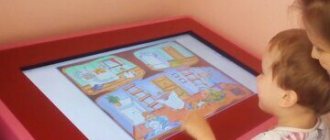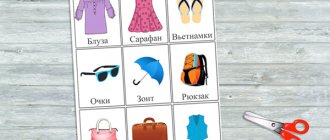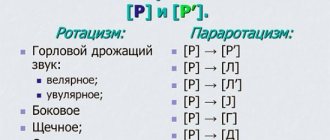Working with five-year-old children is a pleasure. And if until the age of 5 the child still resisted preparing for school, then from this age he dreams of growing up as quickly as possible and becoming a student. Now new knowledge and skills have been discovered, and the maturity of mental functions allows one to concentrate on a task for quite a long time.
In developmental classes, children aged 5-6 years master writing, arithmetic operations, and learn to recognize all the sounds in words. This is also the best time for learning to read; preschoolers study letters with interest and quickly grasp the principle of merging them into syllables.
However, the entire learning process should still be built on gaming activities, and the classes themselves should be distinguished by the variety of tools used. Otherwise, “tedious” lessons will only bring irritation, and the baby will lose interest.
What you need to know about 5 years of age
All babies begin to actively develop from a very early age. They get acquainted with the world around them very quickly and constantly replenish their stock of information, which at first glance seems very simple. Here, parents can find many educational as well as interesting activities for their children that will attract their special attention.
What a five year old should know
Kids of this age will be able to learn to distinguish colors, solve crossword puzzles, train logical thinking, tell time, study animals, plants, and many other useful things. Cognitive activities will help you explore the world in a playful way.
Note! Each game is illustrated with beautiful, bright, memorable pictures, and voice accompaniment will help those kids who do not yet know how to read to quickly master any task. Each completed children's game will develop confidence.
The development of children should not stop for a minute, especially if this is a preschooler (i.e. 1-2 years before entering 1st grade). Educational games for children 5 and 6 years old are more complex tasks. Here children will have to use their thinking to cope with the tasks. The presented tasks will help develop memory, imagination, attention, counting and other qualities important for a preschooler.
Games for a 5-year-old child at home
ATTENTION – ATTENTION
In order for a child to grow up attentive, be able to concentrate and quickly respond to any changes, it is important to train his attention. You can start as early as 4 years of age. At the same time, it is also not necessary to purchase expensive manuals: the suitable “equipment” is always at hand.
For example, you can play these games.
- Variations on the theme “edible - inedible” (sweet - unsweetened, flies - does not fly, clothes - not clothes).
- "What's new?" (on the table, in the picture, in the guise of dad, in mom’s clothes).
- “Find the differences” (in two pictures).
- “Caravan” - the mother names the animal, the child repeats it and adds his own. Mom repeats both and adds a third. You need to repeat in the order in which the animals are named. They play until someone gets lost.
- "What changed?". During a morning walk, mother and child try to remember everything that surrounds them, and in the evening they compare what has changed (someone hung up the laundry, old women sat on a bench, a car drove up to the next door);
- Close your eyes and name as many different sounds as possible in the room (a clock, the noise of a refrigerator, the purring of a cat) or outside the window (cars driving, birds singing, the wind rustling).
- Close your eyes and tell what order is on the shelf, on the table, what mom is wearing.
It is important to start with easier tasks, gradually making them more difficult, and not forgetting to praise your child for success.
What can you play with a 5 year old child at home?
Developmental logic and thinking tasks are designed for children aged 4, 5, 6 years. Here they must demonstrate the ability to think logically when performing various interesting tasks.
Easy math problems are created for children from 4 to 6 years old with the goal of preparing a preschooler for the first mathematical knowledge and ability to count. Interesting colorful entertainment awaits them, in which they will need to find and count the specified number of objects or living creatures.
Important! Memory tasks are created specifically to properly train the memorization of objects and pictures. Such educational games for children are very useful for schoolchildren of any age.
For example, coloring pages that feature numbers cannot be colored at your own discretion, since each color corresponds to a specific numerical value.
Board games
You can open up the interesting world of board games to your child as early as 3-4 years old. At this age, he is already able to understand the simplest rules, a spirit of competition and a desire to win arises in him. But real interest in tabletop activities usually appears later - around the age of five. The maturity of thought processes, the ability to concentrate for a long time and plan actions make such entertainment more accessible to understanding, turning children 5-6 years old into gamblers.
Basics of board games
Important! Board games are popular with children who attend kindergarten, but are already in full swing preparing for school, mastering the first elements of writing, reading, and mental arithmetic. A good board game can provide entertainment between tedious activities, as well as serve as a learning tool and become a source of knowledge.
Developmental activities for children 2 years old - how to do them
Most tasks are focused on the formation of the main mental processes - memory, thinking, attention. But there are options with a narrower focus, which are aimed at teaching counting, literacy, the alphabet of music, familiarization with the features of the surrounding world, and expanding knowledge about objects and phenomena. Children aged five become increasingly familiar with works of art or elements of folk art.
Educational games
The training plan should include not only training sessions using special teaching aids, but also tasks to develop skills that contribute to successful learning at school: perseverance, attentiveness, broad-mindedness, concentration. A cognitive child is already interested in learning and is almost ready for purposeful activity.
Developmental exercises
- Puzzles. If your child likes to solve funny riddles, solve clever puzzles or exciting charades, then you can use the Internet, where you can download many interesting tasks from various online sites.
- Crosswords. Many little scholars love to solve bright, original crossword puzzles, which are also available on the Internet. If you wish, you can print the options you like.
- Math games. Math games will help your child get acquainted with numbers or numbers, learn to count, add, subtract and perform other mathematical operations. Activities like these make learning math easy and fun.
- ABC. The online talking alphabet teaches kids how to pronounce syllables correctly and learn the Russian language. The game method will allow children to learn every syllable in just a few lessons. Bright and colorful alphabets are used especially for children.
Educational games (numbers and shapes)
In order for children to develop faster, parents should pay attention to educational games. For example, you can study colors by looking at interesting pictures, or watch an educational cartoon that is aimed at getting to know the colors of the rainbow.
Note! You need to repeat regularly: red, yellow, blue. Such entertainment develops memory and attention.
Training sessions
Note! There is an interesting game “10 Monkeys” that will teach a child to count from 10 to 1. It looks like an educational cartoon for the little ones. After watching it, every kid will be happy to count dolls, cars, and cards.
There are special educational programs for children in the form of mobile applications to learn numbers along with funny characters. An entertaining lesson will allow kids to count and perform simple mathematical operations. They will find funny poems and bright pictures to make learning numbers and counting fun and interesting.
As a rule, any educational game consists of two parts. In the first part, the child gets acquainted with numbers from 1 to 10. Together with the heroes of the game, the child searches for objects or assembles puzzles. The announcer recites a funny poem about numbers. The second part of the educational children's game is presented in the form of interesting tasks for mastering the acquired material.
For your information! There are special copybooks on sale that teach kids to write numbers from 1 to 10 and visually determine where there is more or less.
Outdoor games
For the normal development of children of any age, outdoor games are needed. Often parents stop attaching importance to the physical training of preschoolers, believing that it is more important for children to learn to read, write and count. Thus, outdoor games fade into the background. Sometimes children are enrolled in sports clubs, where they practice only 6 hours a week, which is not enough.
Moving exercises
Note! Children aged six should move as much as possible. To achieve good results in any other areas, you need to combine study and movement. For example, outdoor games for older preschool children may include elements of mathematics and reading.
Educational song in English for a child - learning the language with children
"Different steps." Typically, children 5–6 years old love not only to read, but also to count. Guys can just keep count without any purpose. In this game, the driver moves some distance away from the children and gives them the task: “walk 7 giant steps,” “take 22 midget steps,” “tread 50 elephant steps,” or “jump 5 steps like a frog.” The game may not be competitive in nature; the child does not necessarily need to reach the finish line faster. This game is not a race, but a kind of warm-up.
"Fanta". At this age, boys and girls begin to actively master reading. Therefore, parents can offer such an active game in which you need to perform not only some actions, but also read tasks. To play “Fanta,” you need to take strips of paper and write in beautiful, legible handwriting what the child must do. Tasks can be more or less active, for example, asking to bring water.
Note! It’s better to play in a group: take turns taking out pieces of paper, reading, and then performing the necessary actions.
READING AND WRITING
Your child will need these skills in school. After all, the first thing he will have to master by first grade is reading and writing.
In the fifth year, you need to plan lessons with your preschooler to prepare your hand for writing. Here you will already need the first teaching aids - children's copybooks. These are excellent “developers” for the hand, helping the child develop the necessary muscles so that the hand does not get tired while writing. In children's copybooks, the child is asked to trace simple patterns point by point and then reproduce them independently.
To reinforce the perception of the first sound in a word (the entire study of letters is based on this), you can glue cards with images of letters to different objects in the house. Let the child determine in which case the card is glued correctly and in which case it is not.
When teaching preschoolers to read, more and more mothers choose Zhukova’s primer. It consistently shows how letters “merge” into syllables and gives important recommendations to parents. In addition, Zhukova’s teaching methods meet the requirements of school curricula.
Advice
Before you start teaching your child to read, teach him to hear all the sounds in words, in different parts of the word (at the beginning, middle, end), and also to isolate syllables in words. You can find many entertaining games for this.
Only with this approach will the child learn to read and write without errors (children often transfer into writing what they hear or perceive incorrectly).
Test
The child development test at 5 years old consists of 7 simple tasks. To carry it out, you must first prepare:
- Three separate images of different times of day (morning, evening, night);
- A picture with 10 or more separate objects that the child knows (ball, chair, sun, etc.);
- A picture with 3 circles of different colors;
- A picture with 3 objects known to the child (spoon, pen, telephone).
Tasks:
- Ask what time of year it is.
- Ask “why do birds fly?” or “why do you have to hold on to the handrail on the bus?” You can come up with your own simple question with a cause-and-effect relationship.
- Ask them to name round (square, triangular) shaped objects in the room.
- Lay out pictures of different times of day in front of the child and ask him to name them.
- Ask them to count them in a picture with 10 or more objects.
- In a picture with 3 circles, ask them to name their color.
- Ask to tell what each of the 3 items from the last picture is needed for.
Every correct answer o.
If there is one “—”, it is recommended to conduct the test for children aged 4 years. If there are one or more disadvantages, the child should be shown to a child psychologist.
Creativity training
Purchase in advance a starter kit for creative activities: an album, brushes, paints, pencils and felt-tip pens. To begin with, let your child practice coloring coloring pages. Buy several close-up coloring books with different themes (preferably one that your son or daughter likes). Explain that the baby should not go beyond the lines, let him learn to be careful now.
It will be great if you study some geometric figure the day before and then color it together. Or, on the contrary, draw a watermelon or an orange, and then ask your child what shape it has.
Do different activities: draw, paint, sculpt, cut out. This way the child will learn the material covered even better.
EDUCATIONAL GAMES FOR CHILDREN – WHY ARE THEY NEEDED AND WHICH ONE IS BETTER TO CHOOSE
The most common type of activity for both preschoolers 4-6 years old and schoolchildren 7-8 years old is still play. Contrary to popular belief, it can be not only entertaining, but also educational. For example, games that develop intelligence can become the basis for teaching children of almost any age, because the game format of classes will attract their attention much better than any other.
Parents can play with their kids and develop their abilities at home by selecting suitable tasks for them aimed at training logic, attention, memory or any other skill. Let's look at a few suitable examples of such tasks and exercises.
Emotional development
At the age of five, the child is not yet able to distinguish between bad and good behavior. Like Mayakovsky in the book “What is good and what is bad.”
Not understanding many things, a withdrawn child is sometimes afraid to ask a question himself. First of all, we need to teach you to trust you.
This is achieved by calm and consistent behavior and sincere interest in the child’s affairs and thoughts.
When something is unclear, a five-year-old child goes to mom or dad and asks.
If you brush off the question, he will be offended. The second step in education after trust should be openness.
Trying to impose generally accepted morality on a child without adhering to it is useless. Therefore, even if the question is unpleasant, it must be answered honestly.
It would be great if, after talking with you, your little one leaves happy and decides for himself that he will do only good things and will not do bad things.
You need to teach your child to be an optimist. This is actually very important. All our illnesses are associated with worries and fears, all failures and disappointments are the result of an incorrect perception of reality.
Try a game you can play every night. Remember all the best events of the day for which you can thank God, and stick smiling faces in your children's diary.
An emotionally stable child will find it easier to overcome developmental milestones on the way to adulthood.
Fine motor skills
By this stage of development, the child’s fine motor skills should be well developed. So, the child should be able to:
- Hold a pencil (pen, brush) correctly and use it with the required pressure;
- Color the picture without going beyond the subject;
- Draw according to the pattern of the figure in the cells;
- Sculpt small parts from plasticine;
- Tie and untie shoelaces.
Features of speech
A child of 5 years old is able to clearly formulate his thoughts using words. He knows how to operate with all parts of speech, construct sentences and pronounce them without hesitation.
- The child can clearly pronounce all sounds (an exception may be the sound “r”);
- uses words of all parts of speech in speech, including different declensions, tenses, verb inflections, plural and singular, superlative and comparative degrees of adjectives, etc.;
- knows how to give intonation to a sentence and determine that of the interlocutor;
- can read a poem with expression;
- knows and easily names the last, first and patronymic names of parents, teachers and his own;
- knows his exact address of residence (including region, city);
- knows and does not confuse the meanings of the words “yesterday”, “today”, “tomorrow”, knows the names of food products and dishes, and if he makes a mistake, he corrects himself.
Math teaching
When the baby is still 2-3 years old, you can gradually begin to teach counting. Count together steps on a walk, toys at home, candies and fruits. Afterwards, you can show your child the counting sticks and start counting them.
It is very effective to learn numbers in pairs (2 and 3, 4 and 5). This will make it easier for your child to understand adding numbers. When you start explaining to him the rule for adding one, it will not be difficult for him to tell you the correct answer. Take one digital pair per lesson, but before taking new material, review what you have covered.
Geometric shapes can be easily and interestingly studied using cookies of different shapes. Start with simple shapes: circle, triangle, square. The store today has cookies to suit different tastes and budgets.
Once you are familiar with simple shapes, you can learn to draw them.
Remember that you will achieve greater results if you alternate activities between each other.
What communication skills should I train my child before going to school?
Living among people is an incredibly difficult job that can take all of a child's strength. Family, kindergarten, home yard and sometimes a store - all this is not such a big world. Compared to the previous ecumene, the school is like a large continent compared to a small island. Everything somehow suddenly became bigger, more significant, somewhere hostility slipped in, somewhere someone else’s gaze scared you, or maybe you were just tired of walking and urgently needed a stop...
In general, I think you will agree: you can send a child to the mainland without the ability to count to one hundred, even without knowing the differences between coniferous trees and deciduous trees... But without social tools, this is absolutely impossible.
Ten social skills every child needs, especially before school:
- Meet, introduce yourself.
- Ask for help. I must say that adults are usually not very good at this. The task of our children is not to repeat our mistakes. Asking for help is not shameful, not offensive, it does not destroy our dignity, especially if we do it politely and with the understanding that our request is legitimate.
- Follow the instructions. We will hone this skill in outdoor games, and then move on to more complex algorithms that you need to be able to hold in your head.
- Concentrate on the task. It is not a neighbor, not a bird outside the window, not an obsessive thought that occupies all my attention - but what I am doing here and now. This is aerobatics, and you cannot demand complete concentration from a first-grader, but we will gradually train attention and teach concentration skills.
- Express your disagreement. If the child does not express it, an emotion will begin to rage within him, which will have to be extinguished, if not immediately, then later, at home. Isn’t it better to immediately get used to speaking in words, politely and still calmly: I don’t think so, it doesn’t seem to me that way, I think differently, maybe differently... Say it and thus give your thoughts the right to exist.
- Accept rejections. Well, they won't ask you today. And we won’t go outside during class. And for some reason that girl over there refused to be friends with you. Well, no, no, but...
- Express gratitude. Just saying “thank you” for giving you a pencil or moving around in the locker room goes a long way. Much more than any copybook.
- Apologize. This is a very difficult competency! Only with a certain level of emotional intelligence can we say, “Forgive me.” Only the understanding that it is not you who is bad, but the situation is such that your anger, your shyness, cheerful prank, stubbornness are legitimate emotions, you just haven’t managed to control it - allows you to apologize and not experience bitter feelings.
- Manage emotions. To be honest, I don’t completely agree with this point. This is too strong a statement: to manage emotions, and even at seven years old! Let this be a “growth” task: for now, the main task is to understand your emotions, understand the reasons, and be able to talk about them. As a result: just don’t throw your fists at children who are “obviously wrong” and don’t cry all day if in the morning reality slightly diverges from the picture in your head. If this works out, that’s great.
- Accept the consequences of your actions and criticism. Another task “for growth”, which does not yet have to be completed to the end. Well, yes, not everything goes smoothly for me. Well, yes, I was wrong, yes, the situation could have been resolved differently. Okay, I'll keep that in mind. And when your child comes to you not just with another “I broke the glass”, but with a tirade “I broke the glass, went up to the teacher, said that I accidentally, apologized and now I ask you to help me fix everything” - honestly, this There will be a good reason to drink champagne!





